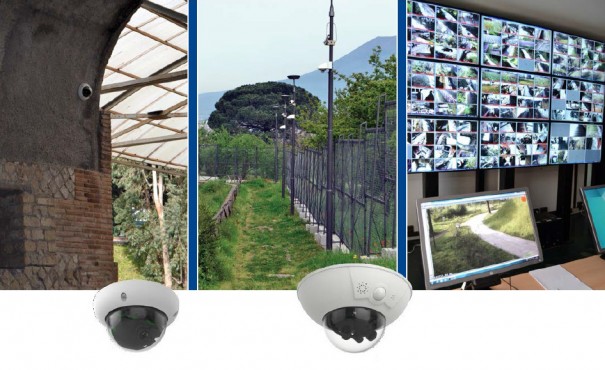Mobotix technology protects Pompeii's archaeological site from vandalism
The need to install a video surveillance system arose as a result of the Gran Pompeii project, focused on conservation, Prevention, maintenance and restoration of this World Heritage-listed area. To this end, a network support infrastructure has been created with 12 fiber optic rings and 88 Nodes; and have settled 240 D15 and D25 cameras, although the goal is to reach the 380 teams this year.
The Pompeii area occupies 440.000 square meters and includes archaeological excavations of this ancient Roman city buried by the eruption of Mount Vesuvius in the year 79 D.c., frozen in time under the sudden rain of ashes and lava that has preserved it for centuries.
In 1997, Unesco declared it a World Heritage Site because it considered that the remains found in Pompeii, Herculanen and other nearby cities buried by the eruption are a living testament to society and daily life that has been preserved virtually intact during the 2.000 Years.
Today, Pompeii is the jewel of the Superintendency of Pompeii, Institute of the Ministry of Goods, Cultural activities and Tourism with special autonomy, who cares about protection, conservation and public access to cultural heritage sites.
Grand Pompeii Project
The need to install a video surveillance system arose as a result of the Gran Pompeii project, an Italian government initiative aimed at increasing the effectiveness of actions and interventions to protect this archaeological site by developing a conservation programme, Prevention, maintenance and restoration.
An operation that had 105 millions of Feder and national funds, whose goal is to modernize the archaeological site, not only stabilizing and restoring walls and decorated surfaces, but also leveraging the video surveillance system to improve security.
The project, supported and accompanied by a technical and scientific curriculum aimed at identifying, research into the scientific knowledge and direction of the various operations, called for a tender bid for a new video surveillance system that was eventually granted to the Italian company Metoda.
"The merit of Metoda is SOA certification, that we obtained precisely by our complex internal organization and that accredits the financial and technical capacity of the company for the design and implementation of large-scale public tenders. The need to implement a video surveillance system was due to several reasons such as the protection of archaeological remains, who are often subjected to theft and vandalism, or the control of tourists", explains Cesare Gonnelli, deputy director of the company.
The archaeological site, you may get to receive 15.000 visitors in a single day (figure surpassed only by the Colosseum) Suffers, often graffiti, scratches and painted on the walls and frescoes of Roman houses, known as domus, that make up the core of the archaeological site. These vandalisms are intentionally perpetrated by tourists with their pens and nails when they manage to stay between the walls, even after the place is closed to the public.
Moreover, as a result of terrorist attacks, the Superintendency considered using an advanced video surveillance system to complement the physical work of vigilantes. "In fact, one of the priorities was to be able to clearly identify people's faces and monitor any anomaly behavior within the area, as well as any abandoned objects deemed potentially suspicious", Gonnelli continues.
As a partner of Mobotix From 2011, Metoda opted for its technology for this project "as it met the requirements for tendering and, In fact, it was the only technology capable of responding to the real needs of the Superintendency".
The first video cameras began to be installed in July 2015, most of them D15, except for about ten D25s chosen to harmonize with architecture and style. In December, Pompeii already had the surveillance of 240 cameras installed in the streetlights surrounding the archaeological site, as well as in the interior and exterior walls of the domus. The ultimate goal is to install more than 380 cameras before it ends this summer.
This video surveillance system is an IT and telecommunications project that posed major challenges, because it was necessary to create a complex network support infrastructure with 12 fiber optic rings and 88 Nodes. This was made possible by Metoda's networking experience, which has a department dedicated exclusively to the development and integration of computer and telecommunications systems.
Video cameras are in operation 24 Hours, But, except for special requirements and despite having a NAS storage system of 700 Tb, are only triggered by events so as not to overload memory. Recordings can be viewed later in 9 monitors 42 inches in a special control room equipped with four workstations for surveillance personnel.
The needs required by this project have been met, as reflected in the fact that a video analysis system is being envisaged to support anti-graffiti measures and thus study behaviors considered 'suspicious'. In this way it would be possible to prevent acts of vandalism that could cause irreparable damage to this artistic and cultural heritage.
You liked this article?
Subscribe to our RSS feed And you won't miss anything.
• Section: Deep down, Case studies, MAIN HIGHLIGHT, Networks, Computer security, Video surveillance




